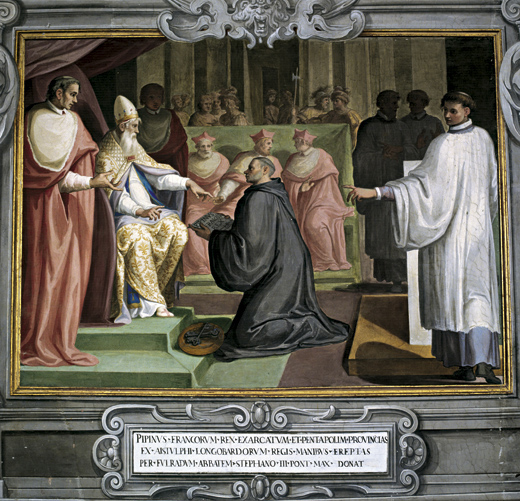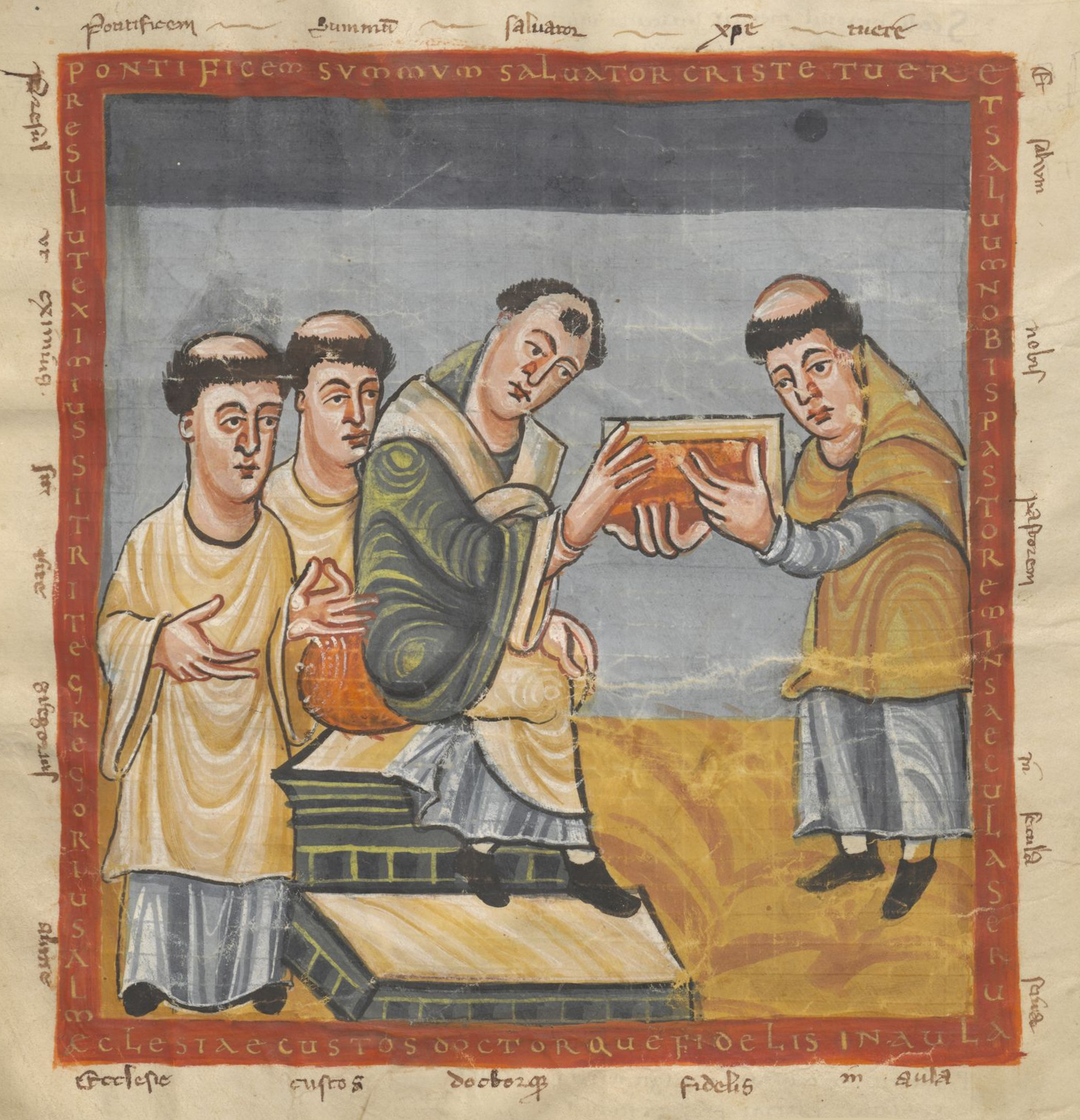|
George Of Ostia
George was a Franco-papal diplomat who served as the bishop of Ostia (753–798) in the Papal State and bishop of Amiens (767–798) in Francia. He moved extensively between Italy and Francia, but his best recorded mission is the one he made to England in 786. Bishop of Ostia before 767 George was a native of Italy. He may have been a Greek from southern Italy and thus a native speaker of Greek. He was apparently the owner of a now lost manuscript of the Greek '' Chronographia Scaligeriana'', which he gave, loaned or sold to the abbey of Corbie around 780, where it was rather clumsily translated into Latin. George is recorded as the bishop of Ostia from 753. In 754, he accompanied Pope Stephen II to the court of the court of the Frankish king Pippin III for the anointing of Pippin and his sons, Charlemagne and Carloman. The ''Liber pontificalis'' lists him first among the pope's followers on this occasion. In early 756, during the Lombard siege of Rome, Stephen sent George ba ... [...More Info...] [...Related Items...] OR: [Wikipedia] [Google] [Baidu] |
Frankish Papacy
From 756 to 857, the papacy shifted from the orbit of the Byzantine Empire to that of the kings of the Franks. Pepin the Short (ruled 751–768), Charlemagne (r. 768–814) (co-ruler with his brother Carloman I until 771), and Louis the Pious (r. 814–840) had considerable influence in the selection and administration of popes. The "Donation of Pepin" (756) ratified a new period of papal rule in central Italy, which became known as the Papal States. This shift was initiated by the Lombards conquering the Exarchate of Ravenna from the Byzantines, strengthened by the Frankish triumph over the Lombards, and ended by the fragmentation of the Frankish Kingdom into West Francia, Middle Francia, and East Francia. Lothair I continued to rule Middle Francia which included much of the Italian peninsula, from 843 to 855. This period was "a critical time in Rome's transformation from ancient capital to powerful bishopric to new state capital." The period was characterized by "battles betwe ... [...More Info...] [...Related Items...] OR: [Wikipedia] [Google] [Baidu] |
Lombards
The Lombards () or Langobards ( la, Langobardi) were a Germanic people who ruled most of the Italian Peninsula from 568 to 774. The medieval Lombard historian Paul the Deacon wrote in the ''History of the Lombards'' (written between 787 and 796) that the Lombards descended from a small tribe called the Winnili,: "From Proto-Germanic '' winna-'', meaning "to fight, win" who dwelt in southern Scandinavia (''Scadanan'') before migrating to seek new lands. By the time of the Roman-era - historians wrote of the Lombards in the 1st century AD, as being one of the Suebian peoples, in what is now northern Germany, near the Elbe river. They continued to migrate south. By the end of the fifth century, the Lombards had moved into the area roughly coinciding with modern Austria and Slovakia north of the Danube, where they subdued the Heruls and later fought frequent wars with the Gepids. The Lombard king Audoin defeated the Gepid leader Thurisind in 551 or 552, and his successor Alboin ... [...More Info...] [...Related Items...] OR: [Wikipedia] [Google] [Baidu] |
Wigbod
Wigbod ( la, Wigbodus, also known as Wigbald or Wigbold) was a theological writer of the eighth century. Of his works there is extant a Latin commentary on the Octateuch called ''Quaestiones in Octateuchum'' that is, on the Five Books of Moses (the Pentateuch), and the books of Josue (Joshua), Judges and Ruth, making eight books in all. He wrote the work, as the full title states, at the command of Charlemagne. As Charlemagne is only called "king of the Franks and Lombards" in the work, not Emperor, it must have been written before the year 800. The form of the book is that of a dialogue between pupil and teacher. The pupil propounds the difficulties and the teacher gives the solution. Wigbold, however, did not compose these answers himself, but gives verbatim, statements by eight Church Fathers: St. Augustine, St. Gregory, St. Jerome, St. Ambrose, St.Hilary of Poitiers, St. Isidore of Seville, St. Eucherius and St. Junilius. For the greater part of Genesis only Jerome and Isido ... [...More Info...] [...Related Items...] OR: [Wikipedia] [Google] [Baidu] |
Theophylact Of Todi
Theophylact or Theophylactus (Latin: ''Theophylactus;'' Greek: Θεοφύλακτος ''Theophylaktos'', "guarded by God") may refer to: * Theophylact Simocatta (7th century), Byzantine author and historian * Theophylactus (Exarch) (died 710), Exarch of Ravenna * Patriarch Theophylactus of Alexandria (7th–8th centuries), coadjutor Greek Orthodox Patriarch of Alexandria * Theophylact of Antioch (8th century), Greek Orthodox Patriarch of Antioch * Archdeacon Theophylact (8th century), archdeacon of the Roman Church * Peter of Atroa or Theophylact (773–837) * Theophylact Rhangabe (8th century), Byzantine admiral * Theophylact (son of Michael I) (793–849), Byzantine co-emperor * Theophylact of Nicomedia (died 845), Bishop of Nicomedia * Theophylact I, Count of Tusculum (9th–10th centuries) * Theophylact of Constantinople (917–956), Patriarch of Constantinople * Theophylact Dalassenos (10th–11th centuries) * Theophylact Botaneiates (fl. died 1014) * Pope Benedict VIII or Theop ... [...More Info...] [...Related Items...] OR: [Wikipedia] [Google] [Baidu] |
Papal Legation
The delegations as they existed in 1859. Between the Congress of Vienna (1815) and the capture of Rome (1870), the Papal State was subdivided geographically into 17 apostolic delegations (''delegazioni apostoliche'') for administrative purposes. These were instituted by Pope Pius VII in a ''motu proprio'' of 6 July 1816: "Quando per ammirabile disposizione". A delegation was known as a legation (''legazione'') when governed by a cardinal. The four northernmost delegations—Bologna, Ferrara, Forlì and Ravenna, which comprised the region known as the Romagne (plural of Romagna)—were regularly governed by cardinals. Thus, the term "Legations" or Papal Legations (''Legazioni pontificie''), when used on its own, often refers to the Romagne. In an administrative reform of 1850, Pius IX grouped the delegations into five larger legations. The four original legations were joined into the legation of the Romagne. In 1859, the Kingdom of Sardinia invaded the Papa ... [...More Info...] [...Related Items...] OR: [Wikipedia] [Google] [Baidu] |
Siege Of Pavia (773–774)
The siege or battle of Pavia was fought in 773–774 in northern Italy, near Ticinum (modern Pavia), and resulted in the victory of the Franks under Charlemagne against the Lombards under King Desiderius. Background Charlemagne, ''rex Francorum'', had succeeded to the throne in 768 jointly with his brother Carloman. At the time there was antagonism between not only the two ruling brothers, but between the king of the Lombards, Desiderius, and the papacy. In 772, Pope Hadrian I expelled all the Lombard officials from the papal curia. In response, Desiderius invaded papal territory, even taking Otriculum (modern Otricoli), just a day's march from Rome.*. Hadrian called Charlemagne for assistance. Charles had produced an alliance with the Lombards by marrying one of Desiderius' daughters, Desiderata; within a year, however, he had changed his mind about the marriage and alliance, and divorced his wife, sending her back to her father. This was taken as an insult by the Lombard ... [...More Info...] [...Related Items...] OR: [Wikipedia] [Google] [Baidu] |
Pope Hadrian I
Pope Adrian I ( la, Hadrianus I; died 25 December 795) was the bishop of Rome and ruler of the Papal States from 1 February 772 to his death. He was the son of Theodore, a Roman nobleman. Adrian and his predecessors had to contend with periodic attempts by the Lombards to expand their holdings in Italy at the expense of the papacy. Not receiving any support from Constantinople, the popes looked for help to the Franks. Adrian's tenure saw the culmination of on-going territorial disputes between Charlemagne and his brother Carloman I. The Lombard king Desiderius supported the claims of Carloman's sons to their late father's land, and requested Pope Adrian crown Carloman's sons "Kings of the Franks". When the Pope failed to do so, Desiderius invaded Papal territory and seized the Duchy of the Pentapolis. Charlemagne besieged Pavia and took the Lombard crown for himself. He then restored the Pentapolis to the Papacy as well as some of the captured Lombard territory. Start of papacy ... [...More Info...] [...Related Items...] OR: [Wikipedia] [Google] [Baidu] |
Lateran Council (769)
The Lateran Council of 769 was a synod held in the Basilica of St. John Lateran to rectify perceived abuses in the papal electoral process which had led to the elevation of the antipopes Constantine II and Philip. It also condemned the rulings of the Council of Hieria. It is perhaps the most important Roman council held during the 8th century.. Background The death of Pope Paul I, on 28 June 767, led to the uncanonical election of two antipopes. Constantine II was a layman who was elevated to the Papal See by his brother Toto of Nepi and a group of Tuscan nobles. He was opposed by another antipope, Philip, who was installed by an envoy of the King of the Lombards, Desiderius, and reigned just for one day, 31 July 768. With the election of Pope Stephen III on 1 August 768, and the forcible removal of the antipopes, Stephen III had sent a request to Pepin the Short, asking for bishops well versed in the Scriptures and in canon law to assist at a synod which would seek to preve ... [...More Info...] [...Related Items...] OR: [Wikipedia] [Google] [Baidu] |
Pope Constantine II
Antipope Constantine II (died c. 769) was a Roman prelate who claimed the papacy from 28 June 767 to 6 August 768. He was overthrown through the intervention of the Lombards and tortured before he was condemned and expelled from the Church during the Lateran Council of 769. Upon the death of Pope Paul I various factions contended to secure the appointment of their respective candidates as pope. Constantine, although a layman, was supported by a group of Tuscan nobles, led by his brother. They secured his election by force of arms. The following spring, local authorities, with Lombard support, succeeded in deposing him. The Lombards then attempted to install their own candidate, a priest named Philip. He, in turn, was overthrown the same day by the local authorities who then elected the churchman Stephen. For a short time Constantine retained some support outside the city, which resulted in armed conflict. The supporters of Stephen had the imprisoned Constantine blinded, which, it ... [...More Info...] [...Related Items...] OR: [Wikipedia] [Google] [Baidu] |
Pope Gregory IV
Pope Gregory IV ( la, Gregorius IV; died 25 January 844) was the bishop of Rome and ruler of the Papal States from October 827 to his death. His pontificate was notable for the papacy’s attempts to intervene in the quarrels between Emperor Louis the Pious and his sons. It also saw the breakup of the Carolingian Empire in 843. Rise to papacy The son of a Roman patrician called John, Gregory was apparently an energetic but mild churchman, renowned for his learning. Consecrated a priest during the pontificate of Pope Paschal I, at the time of Pope Valentine’s death in 827, Gregory was the cardinal priest of the Basilica of St Mark in Rome. Like his predecessor, Gregory was nominated by the nobility, and the electors unanimously agreed that he was the most worthy to become the bishop of Rome. They found him at the Basilica of Saints Cosmas and Damian where, despite his protestations, he was taken and installed at the Lateran Palace, after which he was enthroned as pope-elect so ... [...More Info...] [...Related Items...] OR: [Wikipedia] [Google] [Baidu] |


.png)

